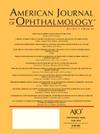Leber先天性黑朦/早发性重度视网膜营养不良少见病因患者的临床特点
IF 4.1
1区 医学
Q1 OPHTHALMOLOGY
引用次数: 0
摘要
目的分析Leber先天性黑朦/早发性重度视网膜营养不良(LCA / EOSRD)罕见基因相关的临床特点、自然病史和遗传学。设计单一三级转诊中心回顾性病例系列。方法回顾19例LCA/EOSRD患者的临床记录、眼科图像和基因检测结果,这些患者的致病基因变异代表所有LCA/EOSRD病例中未知或<1%的基因:ALMS1、CABP4、KCNJ13和OTX2。结果ALMS1-LCA患者6例,CABP4患者7例,OTX2和KCNJ13患者3例。发现了九个以前未报道的变异。所有患者的发病和症状均发生在婴儿期早期,ALMS1和CABP4患者出现畏光,KCNJ13和OTX2患者出现夜盲症。在所有组中,使用世界卫生组织(WHO)视力障碍标准,大多数患者(68%)在就诊时严重视力障碍,并在随访期间发展为失明。ALMS1和KCNJ13患者视力最差最早出现,第二个十年的平均视力分别为2.2和2.8 LogMAR。所有KCNJ13变异体患者均出现黄斑萎缩,KCNJ13的周围视网膜色素沉积密度最大,其次是OTX2。患有ALMS1和CABP4的患者视网膜沉积极少,而患有CABP4的成人患者有中央凹低反射区并伴有全身性视网膜受累。结论描述了4种罕见基因引起的LCA患者的详细遗传和表型特征。横断面和纵向分析有助于我们对这些罕见疾病的理解,旨在改善患者的诊断、预后和管理。本文章由计算机程序翻译,如有差异,请以英文原文为准。
Clinical Characteristics of Patients With Less Common Causes of Leber Congenital Amaurosis/Early-Onset Severe Retinal Dystrophy
Purpose
To analyze the clinical characteristics, natural history, and genetics of Leber congenital amaurosis (LCA) early-onset severe retinal dystrophy (EOSRD) associated with uncommon genes.
Design
Single tertiary referral center, retrospective case series.
Methods
Review of clinical notes, ophthalmic images, and genetic testing results of 19 patients with disease-causing variants in genes that represent an unknown or <1% of all LCA/EOSRD cases: ALMS1, CABP4, KCNJ13, and OTX2.
Results
Six patients were included with ALMS1-LCA, 7 patients with CABP4, and 3 patients with OTX2 and KCNJ13, respectively. Nine previously unreported variants were identified. Disease and symptom onset were during early infancy in all patients, photophobia was seen in patients with ALMS1 and CABP4, and nyctalopia was observed in KCNJ13 and OTX2. Across all groups, using the World Health Organization visual impairment criteria, most patients (68%) were severely sight impaired at presentation and progressed to blindness during follow-up. Poorer vision was seen earliest in patients with ALMS1 and KCNJ13, with mean visual acuities of 2.2 and 2.8 logMAR in the second decade of life. Macular atrophy was present in all patients with KCNJ13 variants, and peripheral retinal pigment deposits were also densest in KCNJ13, followed by OTX2. Patients with ALMS1 and CABP4 had minimal retinal deposits, and adult patients with CABP4 had a foveal hyporeflective zone combined with generalized retinal involvement.
Conclusions
The detailed genetic and phenotypic characteristics of patients with LCA due to four rare genes are described. Cross-sectional and longitudinal analysis contribute to our understanding of these rare diseases, aiming at improving patient diagnosis, prognostication, and management.
求助全文
通过发布文献求助,成功后即可免费获取论文全文。
去求助
来源期刊
CiteScore
9.20
自引率
7.10%
发文量
406
审稿时长
36 days
期刊介绍:
The American Journal of Ophthalmology is a peer-reviewed, scientific publication that welcomes the submission of original, previously unpublished manuscripts directed to ophthalmologists and visual science specialists describing clinical investigations, clinical observations, and clinically relevant laboratory investigations. Published monthly since 1884, the full text of the American Journal of Ophthalmology and supplementary material are also presented online at www.AJO.com and on ScienceDirect.
The American Journal of Ophthalmology publishes Full-Length Articles, Perspectives, Editorials, Correspondences, Books Reports and Announcements. Brief Reports and Case Reports are no longer published. We recommend submitting Brief Reports and Case Reports to our companion publication, the American Journal of Ophthalmology Case Reports.
Manuscripts are accepted with the understanding that they have not been and will not be published elsewhere substantially in any format, and that there are no ethical problems with the content or data collection. Authors may be requested to produce the data upon which the manuscript is based and to answer expeditiously any questions about the manuscript or its authors.

 求助内容:
求助内容: 应助结果提醒方式:
应助结果提醒方式:


